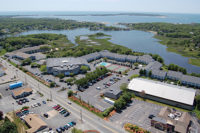McDonald’s continues its sustainability push with the introduction of LEED-certified restaurants. The company is already well down the green building path.
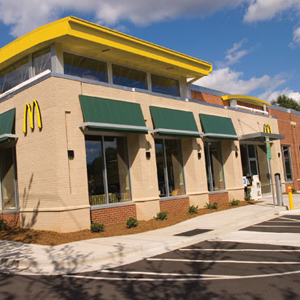
McDonald’s is already well down the green building path.
In recent years, the Oak Brook, Ill.-based restaurant conglomerate has introduced four stores in the United States that have achieved Leadership in Energy and Environmental Design acceditation. A store in Chicago was the first corporate-owned facility to earn LEED credentials when it was awarded Gold certification in 2008. In 2009, the company’s Cary, N.C., restaurant also earned LEED Gold credentials.
Other restaurants in Riverside, Calif., and Savannah, Ga., are LEED-certified, and numerous McDonald’s restaurants outside the United States embrace green building practices, including a restaurant in Beauport, Quebec, that partnered with the Canadian Green Building Council.
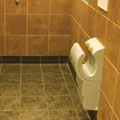
“We’ve made some refinements over the last few years with water and energy efficiency that will contribute to long-term sustainability,” McDonald’s U.S. Restaurant Development Lead Engineer Jason Greenberg, P.E., notes. “We’re introducing technologies that will have an environmental impact.”
McDonald’s wants to make an even bigger splash on the green building front. It plans to pursue LEED certification for 25 additional U.S. restaurants in the next three years as part of a LEED volume program. The 25 restaurants will either be new construction or old restaurants that will be torn down and replaced with LEED-certified facilities.
McDonald’s has been a member of U.S. Green Building Council since 2007 and its participation within the pilot version of the LEED Retail program helped develop the current LEED Retail rating system for all retailers.
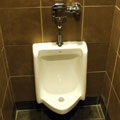
Going with the flow
Some of McDonald’s key sustainable initiatives revolve around water-saving technologies in customer-occupied areas. The LEED-certified restaurants feature high-efficiency toilets and urinals, as well as 0.5-gpm lav faucets.
“The plumbing fixtures are the easiest to implement,” Greenberg says. “There is minimal cost impact and you notice a definite benefit. Water could be at a premium in the future. Our focus is to reduce our water usage. Restaurants are typically big water and energy users. Every little bit we can do will help. Little by little we are implementing these sustainable changes so we can make an even greater impact.”
Behind the counter, LEED restaurants feature high-efficiency T&S Brass spray valves (0.65 gpm) on cleaning sinks and are outfitted with Bradford White high-efficiency water heaters. McDonald’s is investigating ways to reduce washing machine and mop sink water consumption. Numerous high-efficiency appliances proprietary to McDonald’s already help with water and energy usage.

|
|
Figure 1. Industrial and Commercial Application Example |
Greenberg adds implementing green technologies on the customer side is sometimes easier than behind the counter. “The kitchen usage is driven by how much we sell,” he says. “The more you sell, the better the business is and the more usage there is in the kitchen. We’re doing a good job right now minimizing the environmental impact in that area.”
Greenberg explains McDonald’s restaurants do not employ hydronic radiant heating systems because most of the furniture in its dining rooms is drilled into the floor. “That makes it difficult for something like in-floor radiant,” he points out.
The Chicago and Cary restaurants have features such as high-efficiency rooftop mechanical equipment and boilers, high-efficiency interior lighting with skylights and daylight controls, high-efficiency LED lighting for exterior signage and parking lots and green power purchased through renewable energy credits. The restaurant in Riverside boasts light-colored hardscape to reduce site heat emissions and native drought-tolerant plants to reduce water consumption by landscape.
The Chicago LEED Gold restaurant features stormwater management with permeable parking lot pavement and rain gardens, as well as a vegetated green roof. The Riverside location also has a permeable pavement system.
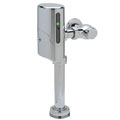
Lowering the meter
When McDonald’s made its initial investment in the LEED-certified restaurants, it pegged a reduction of water consumption in the neighborhood of 35% per restaurant. Zurn Engineered Water Solutions, which has its sustainable products installed in the restrooms of several of McDonald’s LEED-certified stores, published an “Upgrading to a Sustainable Facility” abstract that shows how its green EcoVantage low-flow system fits into the LEED-certification process for a typical commercial office building setting with 100 occupants (50 male and 50 female) in a 260-day work year (See Figure 1).
Zurn offers commercial entities product standardization and market-focused, full-suite solutions and promotes products that feature longer lifecycles, less water usage and result in lower operational costs.
The baseline calculation in the abstract uses the EPA Acts of 1992 and 2005 for gallons per flush/gallons per minute consumption. The results show a total savings over baseline criteria of 40.38%, even higher than McDonald’s initial estimation.
To further its sustainability push, McDonald’s developed a Best of Green program that features a collection of best practices focusing on the environment and provides a tangible positive impact for the company’s business and brand. The report, released earlier this year, illustrates progress in eight categories, including energy, green building and greening the workplace.

“I’m proud of the progress in all these areas and I’m especially excited to see the number of impactful advancements in energy/carbon reduction and green building - two of our key planet priorities,” says Bob Langert, McDonald’s vice president of sustainability.
The report highlights several best green practices used in McDonald’s restaurants throughout the world. For example, a maintenance technician at a McDonald’s restaurant in Brazil suggested reusing condensation generated by the air conditioning unit. The resulting collection, storage and reuse system provided water for plants and cleaning external areas and reduced daily water consumption by 15%.
Greenberg notes renewable energy could be on the green horizon for the company. “One of our next steps is to look at renewable-type energies such as solar,” he says. The Riverside restaurant, which has stood as a McDonald’s property for 44 years, already employs a large 294-panel solar photovoltaic array.
McDonald’s sustainability push isn’t limited solely to restaurants seeking LEED certification. “A lot of stores that are being remodeled are due to include upgrades, such as high-efficiency restroom fixtures,” Greenberg says. “If we talk about the potential to impact several thousand of our stores and increase their efficiencies, it’s a big deal. That is how we will make the greatest environmental impact.”

